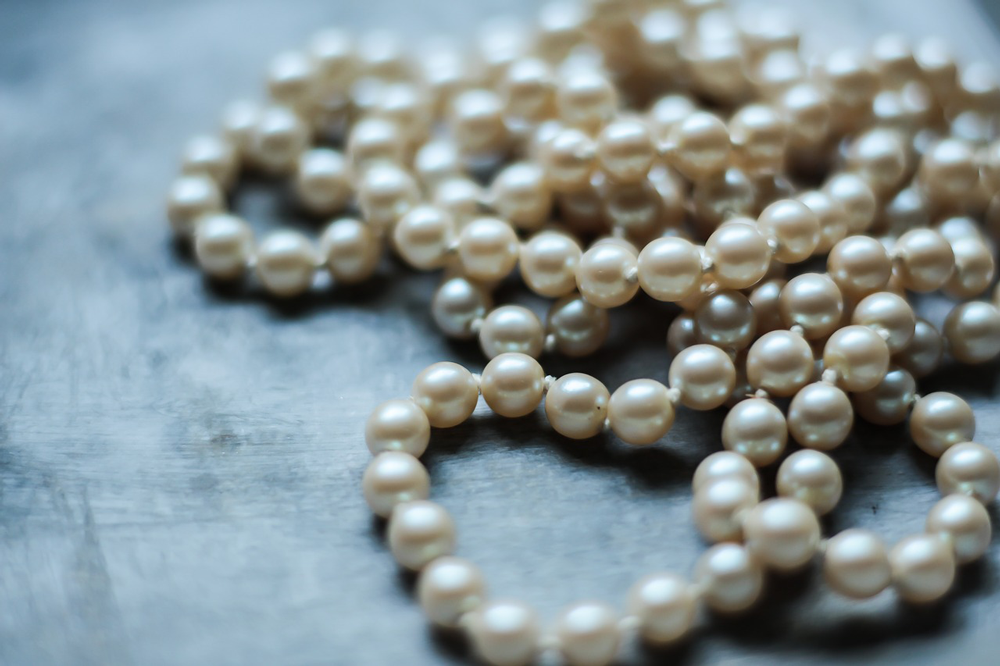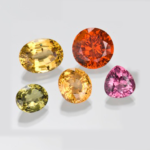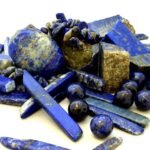Introduction
Pearls are among the oldest and most cherished gemstones in history, admired for their natural beauty, elegance, and symbolism of purity. Unlike other gemstones that require mining and cutting, pearls are formed organically inside oysters and mussels, making them truly unique in the world of jewelry. From classic pearl necklaces to modern pearl engagement rings, pearls have evolved into timeless pieces loved by collectors, fashion enthusiasts, and investors alike. In this guide, we will explore the types of pearls, their value, how to identify real pearls, and why they remain such an enduring choice for jewelry lovers in 2025.
What Are Pearls and How Are They Formed?
A pearl forms when an irritant, such as a grain of sand, enters the shell of an oyster or mussel. The mollusk responds by coating the irritant with layers of nacre, a lustrous material that builds up over time to create a pearl. While natural pearls form without human interference, most pearls available today are cultured pearls, where farmers introduce a nucleus to encourage pearl formation. Despite this, cultured pearls are considered real and genuine. Understanding this process helps buyers appreciate why pearls are different from gemstones like diamonds or sapphires, which are formed deep within the earth.
Healing Properties of Pearls
Beyond their beauty, pearls are believed to possess healing and metaphysical properties. In crystal healing, pearls are said to enhance emotional stability, reduce stress, and encourage self-love. They are also linked with attracting prosperity and protecting the wearer from negative energies. Many people use pearls to strengthen intuition and promote a calm, centered mind. Whether worn daily or during meditation practices, pearls are more than gemstones they are natural symbols of balance and tranquility.
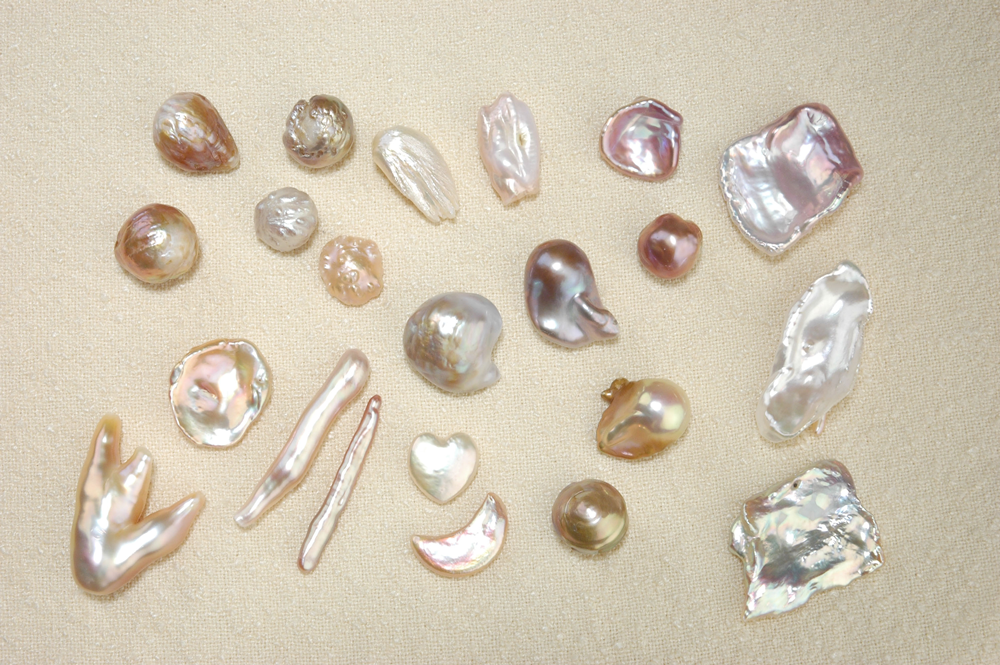
Types of Pearls
Freshwater Pearls – Affordable Elegance
Freshwater pearls are the most widely available type, primarily cultivated in lakes and rivers across China. They are known for their variety in shape, size, and color, making them versatile for different jewelry designs. While generally more affordable than saltwater pearls, high-quality freshwater pearls can still exhibit excellent luster and beauty. These pearls are ideal for those who want the timeless charm of pearls without spending a fortune, making them popular in everyday jewelry such as pearl necklaces, earrings, and bracelets.
Akoya Pearls – The Classic Choice
Akoya pearls, originating mainly from Japan, are renowned for their near-perfect round shape and mirror-like luster. Traditionally, they are the go-to pearls for the iconic white pearl strand necklace that symbolizes elegance and sophistication. Akoya pearls are usually smaller than South Sea or Tahitian pearls but are considered highly valuable due to their consistent quality and shine. They are especially popular among brides, professionals, and anyone seeking a refined look. In 2025, Akoya pearls remain the benchmark for classic pearl jewelry worldwide.
South Sea Pearls – The Luxury Treasure
South Sea pearls are among the largest and most luxurious pearls available, cultivated primarily in the waters of Australia, Indonesia, and the Philippines. Their size can range from 9mm to over 20mm, and their colors vary from silvery white to deep golden. Due to their rarity and impressive appearance, South Sea pearls are considered an investment-worthy gemstone, often selling for thousands of dollars per piece. These pearls are treasured not only for their size but also for their rich, satiny luster that sets them apart from other varieties. Collectors and investors often prefer South Sea pearls as they hold long-term value in the jewelry market.
Tahitian Pearls – Beauty
Tahitian pearls, often referred to as “black pearls,” are primarily cultivated in French Polynesia. Unlike the traditional white pearls, Tahitian pearls display a wide range of dark shades, including black, gray, green, and peacock tones. Their unfamiliar colors and large sizes make them a striking choice for unique jewelry designs. Tahitian pearls appeal to buyers who want something unconventional yet elegant, and they are increasingly popular in modern fashion. As trends in 2025 favor bold and personalized jewelry, Tahitian pearls are gaining even more attention among style-conscious individuals.
Black Freshwater Pearls
Black freshwater pearls are usually dyed to achieve their deep, lustrous color, though some natural dark hues exist. These pearls are appreciated for their affordability and bold appearance, offering a stylish alternative to traditional white or cream-colored pearls. Their striking color makes them popular in contemporary jewelry designs, often combined with silver or white gold to accentuate their rich tone. While not as rare as natural black pearls from the South Seas, black freshwater pearls provide a versatile and budget-friendly option for elegant jewelry.
Real Pearls vs. Fake Pearls
With the growing demand for pearl jewelry, many imitation pearls flood the market, making it important to know how to identify genuine pearls. Real pearls, whether natural or cultured, have subtle irregularities in shape and a unique luster that fake pearls cannot replicate. A simple “tooth test” can help: when rubbed against your teeth, real pearls feel slightly gritty, while fake ones feel smooth. Additionally, genuine pearls tend to feel cool to the touch and are heavier than imitations. Learning these differences ensures buyers can make informed decisions and avoid overpaying for fake products.
How Much Are Pearls Worth?
The value of pearls depends on their type, size, shape, luster, and rarity. Freshwater pearls are the most affordable, typically ranging from $50 to a few hundred dollars, making them accessible for everyday jewelry. Akoya pearls, with their exceptional shine and near-perfect roundness, are more costly and often sought after for classic strands. At the top of the value spectrum are South Sea and Tahitian pearls, which can cost thousands or even tens of thousands of dollars for premium quality pieces. Rare natural pearls remain the most expensive, sometimes auctioned for millions. When buying pearls, always look for authenticity and trusted certification to ensure lasting value.
Popular Pearl Jewelry Styles in 2025
Pearl Necklaces
The pearl necklace remains the most iconic piece of pearl jewelry, with styles ranging from short chokers to long opera strands. Single-strand necklaces are timeless and elegant, while multi-strand designs offer a bold fashion statement. Modern variations include mixing pearls with gold chains or diamonds for a more contemporary look.
Pearl Earrings
Pearl earrings continue to be a favorite choice for their simplicity and sophistication. From classic pearl studs to drop earrings and chandeliers, they suit every occasion, whether casual or formal. Designers in 2025 are experimenting with pearl-and-gold combinations, making them even more versatile.
Pearl Rings & Bracelets
Once considered rare, pearl rings are now gaining popularity, especially in the form of pearl engagement rings. These unique alternatives to diamond rings symbolize purity and individuality. Pearl bracelets, whether single or multi-row, are also trending as fashion statements, often paired with minimalist outfits.
Are Pearls a Good Investment?
Not all pearls are investment-worthy, but certain types hold significant long-term value. South Sea pearls and Tahitian pearls are particularly sought after due to their rarity, size, and unique appearance. Collectors often see them as stable assets in the luxury gemstone market. On the other hand, freshwater pearls are more accessible and suitable for fashion jewelry rather than investment. Buyers should also note that the value of pearls depends on their size, shape, color, and luster. Those considering pearls for investment should focus on certified, high-quality pieces that will retain or appreciate in value over time.
Symbolism and Cultural Importance of Pearls
Throughout history, pearls have held deep cultural and symbolic meanings. In ancient civilizations, pearls symbolized wealth, power, and divine beauty. In modern times, they are often associated with purity, femininity, and elegance. Pearls are also the birthstone for June, making them popular gifts for birthdays, anniversaries, and weddings. Their enduring cultural value ensures they remain one of the most meaningful gemstones across the world.
Color of Pearls
One of the most captivating qualities of pearls is their variety of colors. The most iconic shades are classic white and cream, admired for their purity, but pearls are also found in enchanting hues of pink, lavender, silver, golden, and even foreign black. Each type of pearl offers unique tones: Akoya pearls glow with silver and rose overtones, South Sea pearls display luxurious golden shades, while Tahitian pearls captivate with black, green, and peacock tones. Every color carries symbolism white for innocence, gold for prosperity, and black for mystery allowing wearers to select pearls that resonate with their personality and style.
The Ultimate Guide to Pearls: Nature’s Most Elegant Gemstone
Pearls have enchanted humanity for millennia, symbolizing purity, wisdom, and timeless elegance. These luminous orbs, formed organically within mollusks, stand apart from traditional gemstones due to their living origins. The process through which a pearl forms is a marvel of nature, transforming an irritant into a thing of beauty through layers of nacre. Whether used in heirloom jewelry or modern fashion, pearls hold a revered status in cultures around the world. From royal adornments to bridal necklaces, their natural elegance transcends trends. This article explores the full breadth of pearls, including their types, value, cultural meaning, and significance as the June birthstone.
Meaning of Pearl
The meaning of pearls has fascinated cultures worldwide for centuries. Ancient civilizations saw pearls as symbols of truth, loyalty, and divine wisdom, often linking them to the moon because of their gentle glow. In spiritual traditions, pearls are believed to bring inner peace, clarity of thought, and sincerity in relationships. Today, pearls still embody sophistication, refinement, and grace, making them timeless treasures for anyone seeking both beauty and deeper meaning. As gifts, pearls communicate love, honor, and elegance — values that never go out of style.
Benefits of Pearl
Pearls are admired not only for their beauty but also for their powerful spiritual, emotional, and physical benefits. Wearing pearls is believed to bring inner peace, calmness, and balance to the mind. They are often associated with reducing stress, controlling anger, and enhancing focus, making them a favorite for those seeking emotional stability. In astrology, pearls are linked with the Moon, symbolizing purity and harmony, and are said to strengthen relationships by promoting love and compassion. Physically, pearls are believed to support healthy digestion, improve sleep patterns, and strengthen the heart. Whether worn as jewelry or used in spiritual practices, pearls offer a blend of elegance and healing energy that continues to inspire people worldwide.
How Pearls Are Formed: Nature’s Organic Gemstone
Pearls originate within mollusks such as oysters or mussels when an irritant typically a grain of sand or parasite enters the shell. In response, the mollusk secretes layers of nacre, also known as mother of pearl, to coat the irritant, gradually forming a pearl. This process can take several years and results in a gemstone with a deep, glowing luster. Unlike mined stones, pearls are the only gemstones created by a living creature. The quality and appearance of a pearl depend on the type of mollusk, the water conditions, and the duration of formation. The resulting gem may exhibit a variety of shapes, from perfectly round to baroque, and colors ranging from classic white to rich black and golden hues.
Pearl Jewelry and Fashion
Pearls hold a timeless place in fashion, from classic strands worn by royalty to modern minimalist designs. Today, pearls are styled in countless ways: layered necklaces, stud earrings, pearl-embellished rings, and even contemporary pearl hair accessories. Designers often pair pearls with diamonds or gold to create luxurious statement pieces, while minimalist pearl jewelry appeals to those seeking subtle elegance. Their versatility makes pearls suitable for both formal occasions and everyday wear, proving why they remain a symbol of eternal style.
Pearl as the June Birthstone
Pearl is the traditional birthstone for June, symbolizing purity, wisdom, and emotional balance. Those born in June are believed to benefit from the calming and protective energies of pearls, which are thought to bring harmony in relationships and attract good fortune. Because pearls are organic gemstones formed in water, they are also connected with intuition, compassion, and feminine energy. Pearl jewelry such as necklaces, earrings, and rings are popular gifts for June birthdays, weddings, and anniversaries. Their timeless charm ensures that pearls remain one of the most cherished and meaningful birthstones.
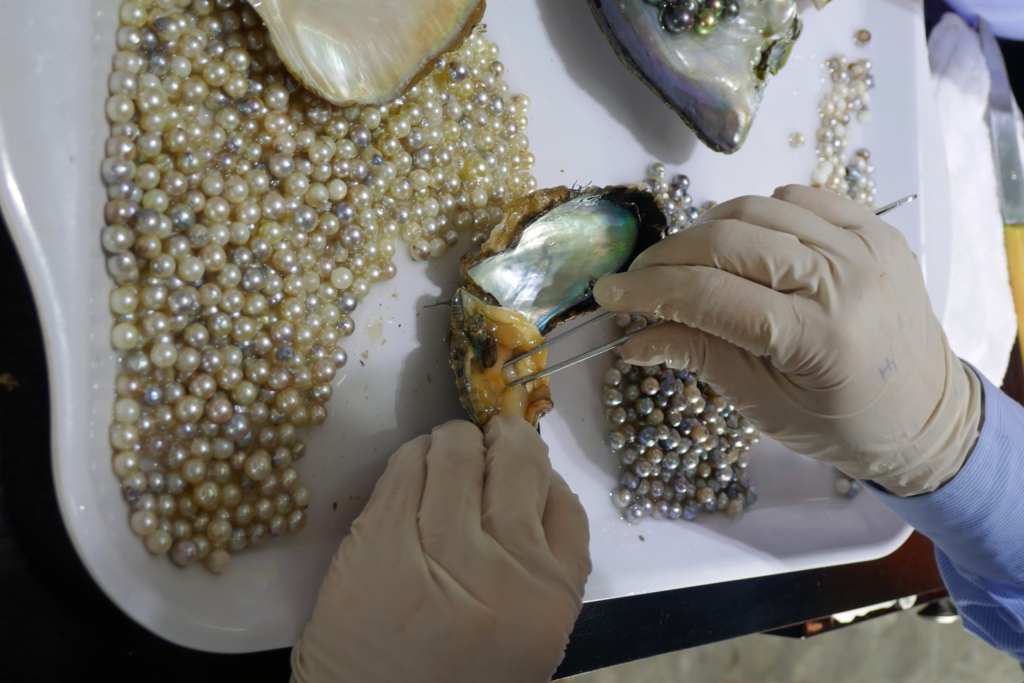
Caring for Pearls
Pearls are delicate and require proper care to maintain their natural beauty. Unlike harder gemstones, pearls can be easily scratched, so they should be stored separately from other jewelry. Avoid exposing pearls to perfumes, cosmetics, or harsh chemicals, as these substances can damage their luster. Cleaning should be done with a soft cloth after wearing them, and it is best to restring pearl necklaces periodically to ensure durability. With proper care, pearls can last for generations, making them a timeless family heirloom.
Frequently Asked Questions abount pearls
Natural pearls form on their own inside mollusks, while cultured pearls are grown with human assistance by inserting a small irritant.
Pearls form when an irritant enters a mollusk, and layers of nacre build up around it over time, creating a lustrous gem.
Nacre, also called mother-of-pearl, is the shiny substance that gives pearls their luster and durability.
Real pearls usually feel gritty when rubbed against teeth, show slight irregularities, feel cool to the touch, and are heavier than imitations.
The most popular types are Freshwater, Akoya, South Sea, and Tahitian, each with unique colors, sizes, and qualities.
South Sea and Tahitian pearls are generally the most valuable due to their size, rarity, and rich luster.
Prices range widely freshwater pearls may start around $100, while top-quality South Sea strands can reach tens of thousands of dollars.
Pearls can be perfectly round, oval, button shaped, drop shaped, or baroque, with each shape offering a distinct beauty.
Luster is the reflection and glow of a pearl. Higher luster pearls appear shinier and more radiant, making them more valuable.
Pearls should be put on last and taken off first, stored in soft fabric, kept away from perfumes and chemicals, and restrung occasionally if worn often.
Conclusion
Pearls are more than just gemstones; they are natural treasures that embody elegance, history, and timeless beauty. Whether you prefer the affordability of freshwater pearls, the classic shine of Akoya pearls, the luxury of South Sea pearls, or the unfamiliar appeal of Tahitian pearls, there is a perfect pearl for every style and budget. In 2025, pearls continue to shine in fashion and investment markets, proving that their allure is truly everlasting. With the right knowledge about types, authenticity, care, and symbolism, buyers can confidently choose pearls that will bring joy and sophistication for years to come.
